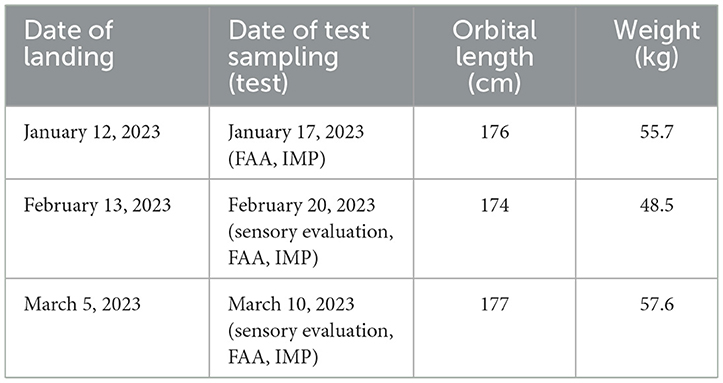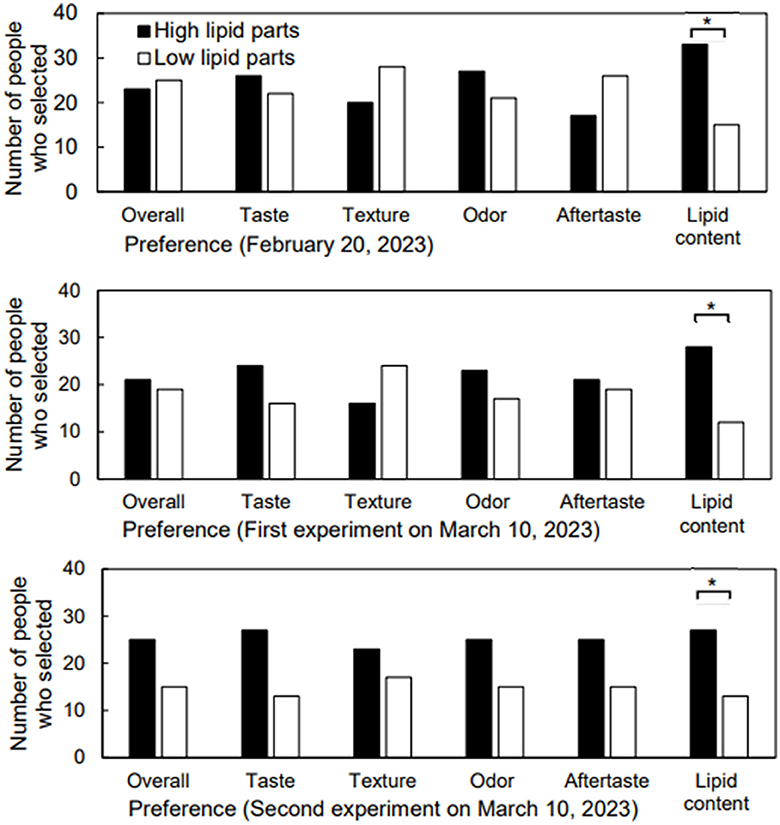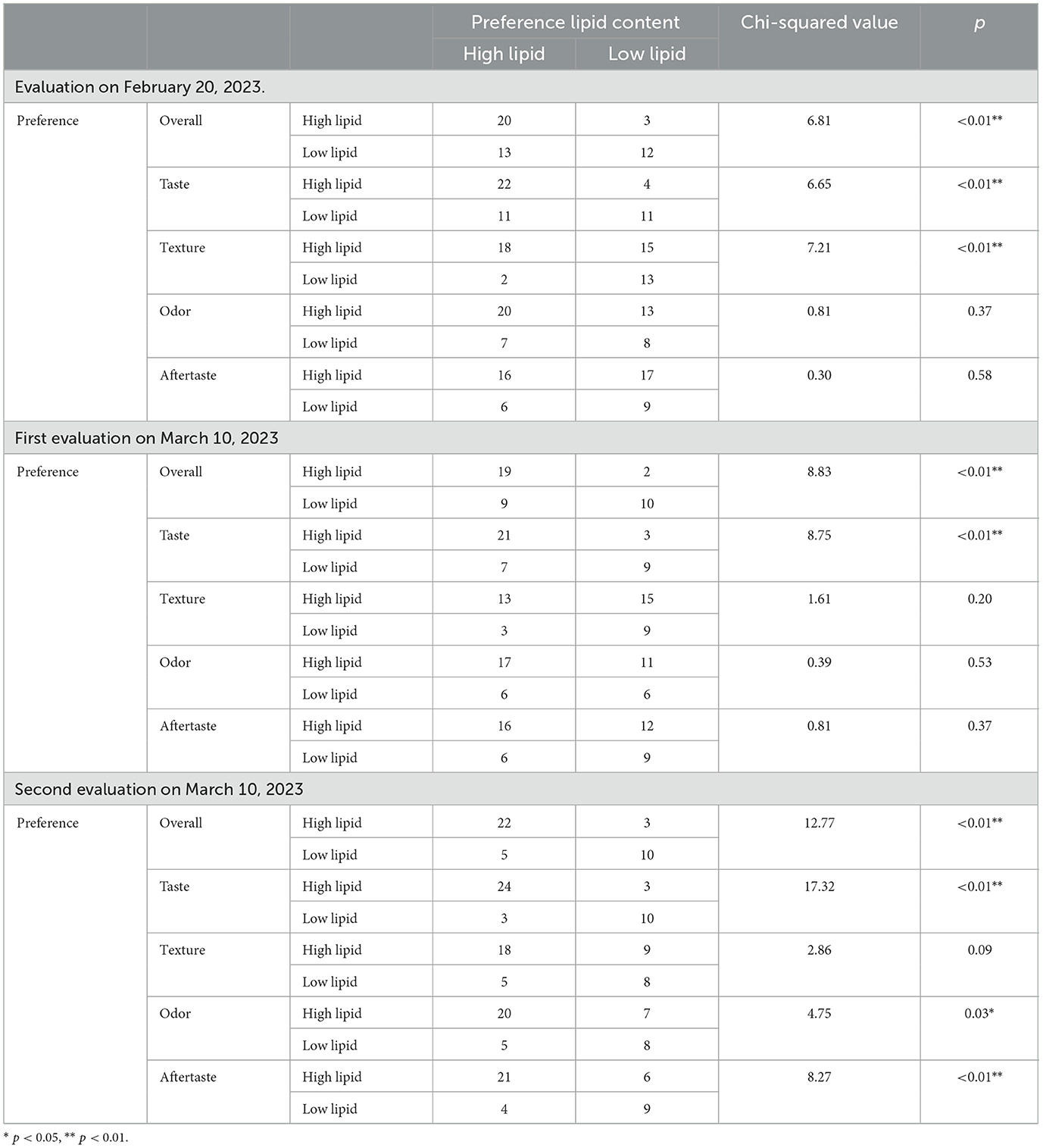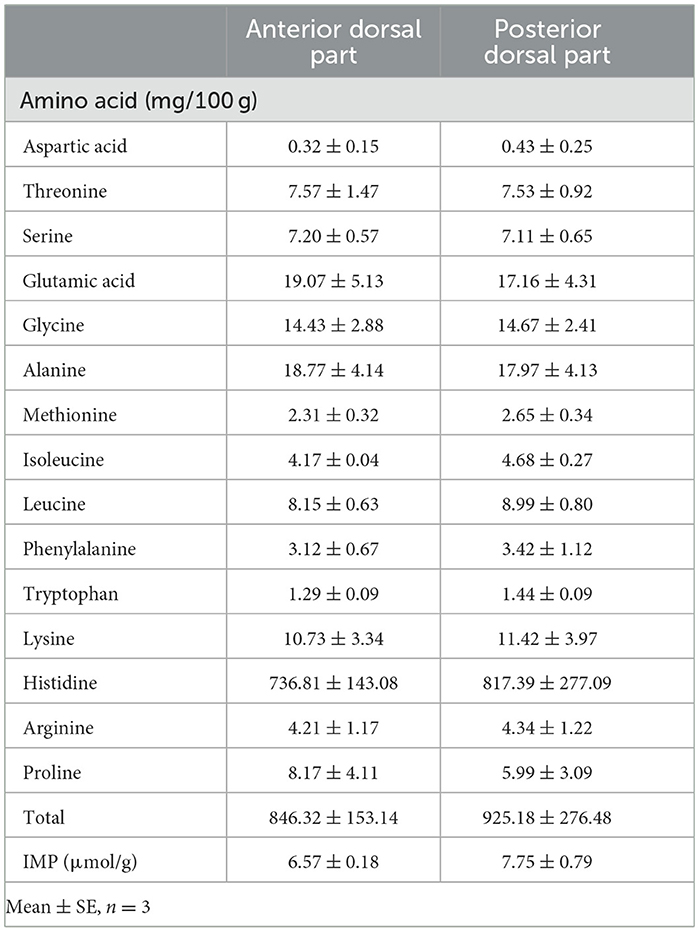- 1Fisheries Technology Institute, Seafood Safety and Technology Division, Japan Fisheries Research and Education Agency, Yokohama, Japan
- 2Chiba Prefectural Fisheries Research Center, Minamiboso, Japan
Identifying the sensory properties of fish consumers is important for providing their preferred seafood. Odor, flavor, texture, and appearance affected the sensory preference for fish. Moreover, several compounds are involved in sensory preference. This study focused on lipids that affect preference for seafood and examined the lipid content preference in marlin Kajikia audax sashimi. First, lipid contents and fatty acid compositions of different individual sizes and body parts of marlin were compared. Next, the preference for overall, taste, texture, odor, aftertaste, and lipid content in marlin sashimi taken from different parts of the body with different amounts of lipids was investigated using the paired preference method. Then the relationship of lipid content preference with other preferences were also evaluated using the Chi-square test. The crude lipid of big-sized marlin (51.1–55.1 kg) was 9.5%−13.2%, and the crude lipid of small-sized marlin (23.5–30.0 kg) was 0.8%−1.2%. The dorsal parts of big-sized marlin had lipid contents in the anterior parts higher than those in the posterior parts (p < 0.05). Whereas no differences were observed in the fatty acid composition of different body parts. The lipid content preference for the anterior dorsal part (high lipid part) was higher than that for the posterior dorsal part (lower lipid part) (p < 0.05). However, no difference in overall preference was observed. Additionally, the relationship between lipid content preference and other preference were indicated that the high lipid content parts preferred group significantly preferred the high lipid content parts at overall and taste evaluation (p < 0.01). On the other hand, the low lipid content parts preferred groups showed opposite evaluation. Therefore, the lipid content was associated with the preference for marlin sashimi and be classified into two groups: one prefers high lipid sashimi and the other prefers low lipid sashimi.
1 Introduction
Food quality detectable by our senses can be divided into appearance, textural, and flavor factors (Norman and Joseph, 1998). Food quality is influenced by taste, appearance, and nutrition, among these factors, lipids are important components of the taste of seafood. In seafood, the amount of lipids is a factor that affects taste. In our previous studies, the general composition such as crude lipid and water content, texture, and muscle structure of mackerels were investigated (Hashimoto et al., 2017, 2019; Hashimoto and Yamashita, 2019, 2023a,b). Factors and features associated with the deterioration of the raw materials for sashimi were identified. However, the influence of lipids on the taste perceived by consumers remains unknown. Therefore, to fully understand the consumer preference, the detailed regulatory mechanism of lipids should be elucidated.
Lipid content has attracted attention as a factor related to consumer preference. Previous research has suggested that lipid content is related to taste. Hayashi et al. (1981) found that only 12 components contributed toward producing the characteristic taste of the snow crab. Koriyama et al. (2000) found that the effects of oil on the taste of tuna extract depend on oil variety and the quantity of oil added. Nishimura and Egusa (2019) found that sensory analyses showed that the addition of umami compounds to the sausage mix enhanced the intensity of retronasal aroma sensation, the flavor complexity, the lingeringness of taste, and the intensity of the umami of the sausage. However, how lipid content affects with consumer preference remains to be elucidated. Therefore, this study aimed to examine whether high lipid content affects the taste perceived by consumers. Sensory evaluation was performed using two samples with different lipid contents.
2 Materials and methods
2.1 Materials
Marlins were caught using a longline Fishery and landed at Katsuura port in Chiba Prefecture, Japan, between December 2019 and March 2023 [samples for analysis of crude lipid content and fatty acid composition are shown in Table 1, samples for free amino acid (FAA) composition and inosine 5'- monophosphate (IMP) content samples are shown in Table 2]. These weights do not include organs. Because market participants treat a marlin that weighs over 40 kg as big-sized, this study also refers to a marlin that weighs over 40 kg as a big-sized marlin and under 40 kg as a small-sized marlin (Table 1). After landing, the fish were kept ice cold until brought to our laboratory. The fish were then cut into 20-cm-length blocks (Figure 1). The sensory test samples were wrapped in polyethylene bags and stored at approximately 0°C for 5–7 days after landing. We prepared 10-mm slices of muscles from blocks for the sensory test. The remaining portion of the blocks was used for crude lipid content analyses.
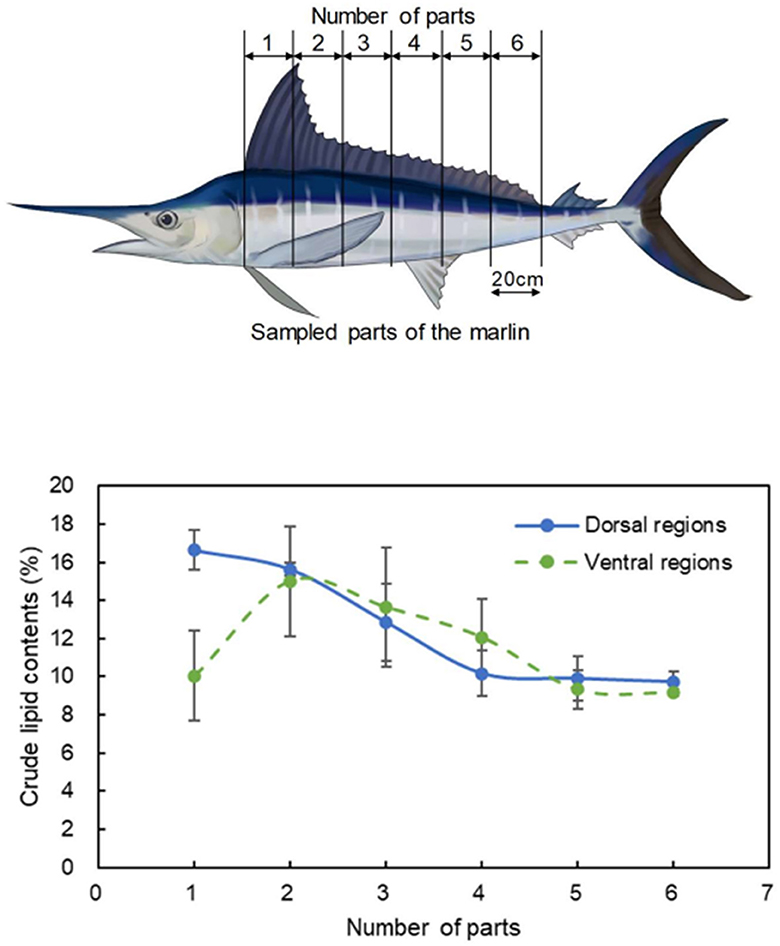
Figure 1. Comparison of lipid contents of different body parts of big-sized marlins (51.1–55.1 kg). Data are presented as means ± SE (n = 3). No significant differences in the crude lipid content of the ventral regions muscle were observed. Different uppercase letters above sampling dates indicate significant differences between different body parts in the dorsal regions of the marlin muscle (p < 0.05).
2.2 Analysis of crude lipid content and fatty acid composition
White muscle specimens of samples shown in Table 1 were used to analyze the crude lipid content. The crude lipid content was measured using Soxhlet extraction (Min and Steenson, 1998). The crude lipid contents by each marlin (Table 1) and different body parts (Figure 1) of big-sized marlin were investigated. In addition, white muscle specimens from the anterior and posterior parts of 23.5, 30.0, 55.1, and 51.1 kg marlins (Table 1) were used to analyze fatty acid composition. Extracts for fatty acid analysis were prepared according to the procedure of Folch et al. (1957), and fatty acid methyl esters were prepared by transesterification with 15% BF3-MeOH (Sigma, St. Louis, MO, USA). Those methyl esters samples were analyzed using gas chromatography (Shimazu, GC-2014, Japan), equipped with a FUSED SILICA capillary column (Omegawax250, 30 m × 0.25 mm, film thickness 0.25 μm; Supelco, USA). A flame ionization detector was used to detect fatty acid methyl esters. The oven temperature was set at 205°C, and the injection and detection temperatures were 260°C. Helium was used as the carrier gas. Fatty acids were identified by comparing with retention times of standard fatty acid methyl esters (PUFA3-A, Menhaden Oil; Supelco).
2.3 Sensory evaluation
Sensory evaluation was conducted to determine the preference for different amounts of lipid content of marlin sashimi and carried out with the participation of 48 for the February 20th tests and 40 for the March 10th test who were untrained volunteer panelists of our institute aged between 20 and 60 s.
Different amounts of lipid content samples were used for the sensory evaluation of the paired preference method. In the sensory evaluation, the panelists evaluated the preference for marlin sashimi on six points: overall, taste, texture, odor, aftertaste, and lipid content. The panelists wore red sunglasses during the evaluation to eliminate visual information. We confirmed that the panelists couldn't distinguished the color of the sashimi. Furthermore, panelists rinsed their mouths with water between each sample to avoid carryover effects. Samples for evaluation were cut into 10-mm-thick pieces from the anterior dorsal part and posterior dorsal part. The anterior dorsal part was the high lipid content parts, the crude lipid content of marlin landed on February 20th and March 10th were 9.6% and 12.8% respectively. On the other hands the posterior dorsal part was low lipid contents parts, the crude lipid content of marlin landed on February 20th and March 10th were 2.1% and 0.8% respectively. Panelists evaluated the relationship between lipid content preferences and overall preference, taste, texture, and odor preference.
2.4 Analysis of the FAA composition and IMP content of marlin muscles
Samples in Table 2 were used to analyze the FAA composition and IMP content. The sample extraction method was followed as per JAS0023 (2022). The FAA concentrations were analyzed using an automatic amino acid analyzer (L-8900; High-Technologies, Tokyo). In addition, nucleotides and their related compounds were determined by high-performance liquid chromatography (LC-20AD; Shimadzu, Kyoto, Japan) with an Asahipak GS-320HQ column (Showa Denko, Tokyo) followed as JAS0023.
2.5 Statistical analysis
Comparison of crude lipid contents in different parts of marlin was analyzed using one-way analysis of variance (ANOVA), followed by Tukey's multiple comparison test using R software v.2.8.1. In addition, comparison of fatty acid components in different parts of marlin was performed using t-tests implemented in Excel Statistics for Windows 11 (Microsoft Corp., Redwood, WA, USA). We confirmed the relationship between lipid content preferences and the overall preference, taste, texture, and odor preference using the chi-squared test.
3 Results and discussion
3.1 Comparison of lipid contents by individual size and body part
We confirmed that the lipid content differs depending on the size and body parts of individual marlin. The crude lipid contents of the muscle for different sizes of marlin are shown in Table 1. The crude lipid of big-sized marlin (51.1–55.1 kg) was 9.5%−13.2%, and the crude lipid of small-sized marlin (23.5–30.0 kg) was 0.8%−1.2%. The lipid contents of big-sized marlin were higher than that of small-sized marlin. A comparison of lipid contents by different body parts of the big-sized marlin is shown in Figure 1. Comparisons were performed at different parts on the dorsal regions. Similar comparisons were made at different ventral regions. No significant differences in the crude lipid content of different parts of the ventral regions. However, in the dorsal regions, the crude lipid content of the no. 1 part, the anterior part, was significantly higher than that of nos. 3–6, the posterior parts (ANOVA, p < 0.05), additionally, the crude lipid content of the no. 2 part, the anterior part, was significantly higher than that of no. 4–6, the posterior parts (ANOVA, p < 0.05). Overall, the crude lipid content of the anterior dorsal parts was significantly higher than that of the posterior dorsal parts. The seafood wholesaler said that marlins have a lot of lipids on the anterior dorsal parts. These data confirm this seafood wholesaler's experience. In this study, we used a big-sized marlin as a sample and compared the preference between the anterior dorsal parts (high lipid contents) and the posterior dorsal parts (low lipid contents).
3.2 Fatty acid composition of crude lipids in different parts of marlin
Whether the fatty acid composition differs depending on the body part of the marlin was investigated. Fatty acid compositions of crude lipids in different parts of marlin are shown in Figure 2. No significant differences were observed between the anterior and posterior parts of fatty acid compositions. Differences in fatty acids might cause preference differences; however, no difference in fatty acid compositions was observed in different parts of a marlin. This effect is considered negligible in the different body parts of marlin.
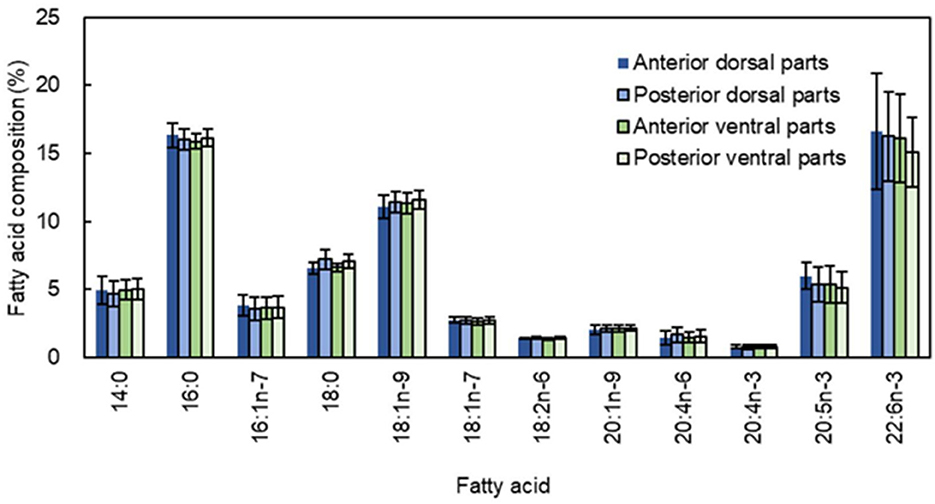
Figure 2. Fatty acid composition of crude lipid in different body parts of big-sized marlins (51.1–55.1 kg). Data are presented as means ± SE (n = 4). No significant differences in the fatty acid composition of crude lipid content of marlin muscles were observed.
3.3 Panelists' preference for marlin sashimi with different lipid contents muscle
We confirmed the panelists' preference for marlin sashimi with different lipid contents muscle. Selectivity in different lipid content parts is shown in Figure 3. The lipid content preference for the high lipid part was higher than that for the low lipid part. Many people felt that the high lipid part was preferable to the low lipid part in terms of lipid content preference (t-test, p < 0.05). However, no difference in overall preference was observed. Panelists feel that high lipid samples are preferred in the lipid content preference; however, panelists do not necessarily feel that high lipid samples are preferred in overall preference.
3.4 Relationship between lipid content preference and other preferences
We investigated how the preference for lipid content affects other evaluations. The relationship between lipid content preference and other preferences is shown in Table 3. We confirmed the relationship between lipid content preferences and the overall preference, taste, texture, and odor preference. We conducted a Chi-squared test in these three evaluations, and lipid content preference was associated with the overall and taste preference in all evaluations. From this analysis, it was clarified that the lipid content affected the overall and taste preference for marlin sashimi. It was supposed that there was a group of people that preferred high lipid sashimi, while there was a group of people that preferred low lipid sashimi, and those preference was affect by lipid content.
3.5 FAA composition and IMP content in different parts of marlins
Taste components such as FAA and IMP are known to influence food preferences (Nalan and Pinar, 2015). Therefore, we compared the contents of FAA and IMP in the anterior and posterior dorsal parts of marlins (Table 4) and found no significant difference between the anterior and posterior dorsal parts of marlins. Therefore, the taste component effect is negligible in this study.
4 Discussion
This study found the consumer preference for marlin sashimi. The amount of lipid content may also influence consumer preference and be classified into two groups: one prefers high lipid sashimi and the other prefers low lipid sashimi.
We confirmed crude lipid contents and fatty acid composition in Table 1 and Figures 1, 2. From this data, we clarified the lipid status characteristics of marlins. Differences in fatty acids might affect seafood preference (Torstensen et al., 2005; Stone et al., 2010), so these components were analyzed. However, no difference in fatty acid compositions was observed in different parts of the marlin, therefore, this effect is negligible. While sensory evaluation was conducted on rainbow trout (Stone et al., 2010), Atlantic Salmon (Torstensen et al., 2005) fed diets supplemented with oil showed different fatty acid compositions. It indicated that preferences were dependent on the fatty acid composition of oil. However, in beef, no difference in preference was observed even if the fatty acid composition was different (Kerth et al., 2015). Thus, it cannot be denied that fatty acid composition affects seafood preference. Further studies should confirm the effects of fatty acid composition.
Additionally, taste components such as FAA and IMP are known to influence food preference. We confirmed no difference in FAA and IMP content (Table 4). Therefore, the taste component effect is negligible in this study.
We also confirmed the panelists' preference for marlin sashimi with muscle with different lipid contents in Figure 3 and Table 3. Panelists feel that high lipid samples are preferred in the lipid content preference; however, panelists do not necessarily feel that high lipid samples are preferred in overall preference in Figure 3. Whereas, the lipid content affected the overall and taste preference, because some panelists preferred the high lipid content, while others preferred the low lipid content in Table 3. These results may indicate that high lipid sashimi is not always preferred. In beef, almost the same phenomenon is observed. Sasaki et al. (2017) reported that although the major trend of Japanese consumers' beef preference was “marbling liking,” 16.9% preferred beef samples with moderate marbling and distinctive taste. It indicated that not all consumers show a high preference for meat with high-fat content. A similar trend may exist in this study for marlin sashimi. Furthermore, consumer preference might be influenced by age, sexuality, eating experience of sashimi, health status, and internal organ function. We interviewed the panelists after the study, who expressed the opinion that they do not like eating high amounts of lipid seafood because it makes them feel sick. In addition, the age and gender of the panelists were asked in that sensory evaluation, then, we confirmed the relationship between these factors and their preferences. No relationship was found with these factors. To clarify this relationship, it is necessary to evaluate seafood preference with more panelists than in this study. Overall, these results suggest that the amount of lipid content may also influence consumer preference and be classified into two groups: one prefers high lipid sashimi and the other prefers low lipid sashimi. However, further studies are required to reveal the consumer preference for seafood, so we would like to continue testing using a variety of fish species to clarify consumers' preferences for seafood.
Data availability statement
The original contributions presented in the study are included in the article/supplementary material, further inquiries can be directed to the corresponding author.
Ethics statement
Ethical approval was not required for the study involving animals in accordance with the local legislation and institutional requirements because not applicable. This article does not contain any studies with human or animal participants. Fresh fish samples for food processing were obtained from fishermen and fish market. Written informed consent was obtained from the individual(s) for the publication of any potentially identifiable images or data included in this article.
Author contributions
KH: Investigation, Writing – original draft. TK: Investigation, Writing – review & editing. YM: Writing – review & editing. SI: Writing – review & editing. TS: Writing – review & editing. KI: Writing – review & editing.
Funding
The author(s) declare that no financial support was received for the research, authorship, and/or publication of this article.
Acknowledgments
The authors express appreciation to Mr. Watanabe of the Shinkatsuura Fisheries Cooperative Association for sampling marlin, Drs. Keisuke Sasaki and Genya Watanabe for their assistance in drafting the manuscript, and Manami Hashimoto for illustrated the marlin in Figure 1.
Conflict of interest
The authors declare that the research was conducted in the absence of any commercial or financial relationships that could be construed as a potential conflict of interest.
Publisher's note
All claims expressed in this article are solely those of the authors and do not necessarily represent those of their affiliated organizations, or those of the publisher, the editors and the reviewers. Any product that may be evaluated in this article, or claim that may be made by its manufacturer, is not guaranteed or endorsed by the publisher.
References
Folch, J., Lees, M., and Stanley, S. G. H. (1957). A simple method for the isolation and purification of total lipides from animal tissues. J. Biol. Chem. 226, 497–509. doi: 10.1016/S0021-9258(18)64849-5
Hashimoto, K., Kobayashi, S., and Yamashita, M. (2017). Comparison of connective tissue structure and muscle toughness of spotted mackerel Scomber australasicus and Pacific mackerel S. japonicus during chilled and frozen storage. Fish Sci. 83,133–139. doi: 10.1007/s12562-016-1042-4
Hashimoto, K., Osaki, S., Kawamura, W., and Yazawa, R. (2019). Meat quality of frozen hybrid mackerel (Scomber australasicus × Scomber japonicus). Fish Sci. 85, 877–882. doi: 10.1007/s12562-019-01332-0
Hashimoto, K., and Yamashita, M. (2019). Seasonal variation in quality and chemical composition of the muscles of the spotted mackerel Scomber australasicus and Pacific mackerel S. japonicus. Fish Sci. 85, 767–775. doi: 10.1007/s12562-019-01324-0
Hashimoto, K., and Yamashita, M. (2023a). Seasonal variations in the drip rate and toughness of frozen–thawed muscles of the spotted mackerel Scomber australasicus and the Pacific mackerel Scomber japonicus, and the relationship of pH and water content with meat quality. Fish Sci. 89, 263–270. doi: 10.1007/s12562-023-01669-7
Hashimoto, K., and Yamashita, M. (2023b). Comparison of muscle color and total selenium concentrations between spotted mackerel Scomber australasicus and Pacific mackerel S. japonicus. Mar. Biotechnol. 25, 652–656. doi: 10.1007/s10126-023-10230-7
Hayashi, T., Yamaguchi, K., and Konosu, S. (1981). Sensory analysis of taste-active components in the extract of boiled snow crab meat. J. Food Sci. 46, 479–483. doi: 10.1111/j.1365-2621.1981.tb04890.x
JAS0023 (2022). Testing method of K-value as a freshness index for fish -high performance liquid chromatographic method. Japanese Agricultural Standard.
Kerth, C. R., Harbison, A. L., Smith, S. B., and Miller, R. K. (2015). Consumer sensory evaluation, fatty acid composition, and shelf-life of ground beef with subcutaneous fat trimmings from different carcass locations. Meat Sci. 104, 30–36. doi: 10.1016/j.meatsci.2015.01.014
Koriyama, T., Kohata, T., Watanabe, K., and Abe, H. (2000). The effect of oils on the taste of tuna extract. Nippon Suisan Gakkaishi. 66, 876–881. doi: 10.2331/suisan.66.876
Min, D. B., and Steenson, D. F. (1998). “Crude fat analysis,” in Food Analysis, ed. S. S. Nielsen (Frederick: Aspen Publishers).
Nalan, G., and Pinar, Y. (2015). Seafood Chilling, Refrigeration and Freezing. London, UK: John Wiley and Sons, Ltd.
Nishimura, T., and Egusa, S. (2019). Koku in Food Science and Physiology. Singapore: Springer. doi: 10.1007/978-981-13-8453-0
Norman, N. P., and Joseph, H. H. (1998). Food Science. 5th edition. New York, NY, USA: Springer Science +Business Media, Inc.
Sasaki, K., Ooi, M., Nagura, N., Motoyama, M., Narita, T., Oe, M., et al. (2017). Classification and characterization of Japanese consumers' beef preferences by external preference mapping. J. Sci. Food Agric. 97, 3453–3462. doi: 10.1002/jsfa.8204
Stone, A. J. D., Olivia, C. M. A., Ross, F. C., Plante, S. S., Smiley, S. P., Bechtel, P., et al. (2010). The effects of phase-feeding rainbow trout (Oncorhynchus mykiss) with canola oil and Alaskan pollock fish oil on fillet fatty acid composition and sensory attributes. Aquac. Nutri. 17, e521–529. doi: 10.1111/j.1365-2095.2010.00792.x
Torstensen, B. E., Bell, J. G., Rosenlund, G., Henderson, R. J., Graff, I. E., Tocher, D. R., et al. (2005). Tailoring of Atlantic salmon (Salmo salar L.) flesh lipid composition and sensory quality by replacing fish oil with a vegetable oil blend. J. Agric. Food Chem. 53, 10166–10178. doi: 10.1021/jf051308i
Keywords: sensory evaluation, preference, marlin, sashimi, lipid content
Citation: Hashimoto K, Kawashima T, Murata Y, Imamura S, Seko T and Ishihara K (2024) Investigation of the preference of marlin Kajikia audax sashimi with different lipid contents through sensory evaluation. Front. Sustain. Food Syst. 8:1356673. doi: 10.3389/fsufs.2024.1356673
Received: 16 December 2023; Accepted: 14 May 2024;
Published: 03 June 2024.
Edited by:
Chunhong Yuan, Iwate University, JapanReviewed by:
Eduardo Esteves, University of Algarve, Portugal徹 Ooizumi, Fukui Prefectural University, Japan
Copyright © 2024 Hashimoto, Kawashima, Murata, Imamura, Seko and Ishihara. This is an open-access article distributed under the terms of the Creative Commons Attribution License (CC BY). The use, distribution or reproduction in other forums is permitted, provided the original author(s) and the copyright owner(s) are credited and that the original publication in this journal is cited, in accordance with accepted academic practice. No use, distribution or reproduction is permitted which does not comply with these terms.
*Correspondence: Kanako Hashimoto, aGFzaGltb3RvX2thbmFrbzA1QGZyYS5nby5qcA==
 Kanako Hashimoto
Kanako Hashimoto Tokifusa Kawashima2
Tokifusa Kawashima2 Takuya Seko
Takuya Seko Kenji Ishihara
Kenji Ishihara
